Celestial in its reach, the Richard S. Shineman Center for Science, Engineering and Innovation is also practical to the core — a visionary platform for launching careers in the physical sciences while tackling urgent issues of environmental sustainability.
From its 35-seat planetarium to its 240 energy-efficient geothermal wells, the complex showcases Oswego’s ever-growing commitment to scholarship and research in the fields of science, technology, engineering and mathematics.
The $118 million Shineman Center is a visionary configuration of laboratories, observatories, and stimulating learning and gathering spaces. Both high-tech and humanistic, it’s the crown jewel of Oswego’s recent 10-year capital expansion.
EDWARD AUSTIN SHELDON LEGACY
Presentation by Casey Raymond and Allen Bradberry
Exactly 100 years ago, Oswego unveiled its first future-focused building, the beautiful, stately Sheldon Hall, and celebrated its then-progressive approach to teacher training. In architecture and infrastructure, Sheldon Hall and the Shineman Center have little in common. In spirit, they are one — legacies of Edward
Austin Sheldon, who energized American education by replacing memorization with dynamic, hands-on, student-centered learning.
President Deborah F. Stanley, acknowledging the commonalities, said, “Today, Dr. Sheldon would agree that the dedication of the Richard S. Shineman Center for Science, Engineering and Innovation has helped meet his stated goal to ‘raise Oswego to its highest degree of usefulness’ in the pursuit of academic excellence as we prepare the next generation of exceptionally trained and globally engaged scientists and engineers in the STEM fields and beyond.”
A testament to Sheldon’s student-minded spirit is the building’s $5 million naming gift — the largest cash gift in college history — from two dedicated former faculty members, Dr. Barbara Palmer Shineman ’65 M ’71 and Dr. Richard S. Shineman, who — before his death in 2010 — created a bequest that established the foundation that bears his name.
“Dick and Barbara have been longtime, generous supporters of our college,” President Stanley said. “They epitomize the loyalty and devotion of the entire SUNY Oswego community. Their gift, moreover, reaches a new dimension and carries Oswego to new heights.”
CHEMIST, PHILANTHROPIST, CATALYST
At the center’s dedication, professor emeritus Richard Shineman was center stage. His wife, professor emerita of education Dr. Barbara Shineman, said her unpretentious husband, founding chair of the college’s department of chemistry, “would be more than a little embarrassed that we are calling attention to him today. But,” she continued, “while he had no self pride, he was proud of Oswego.
 “This is a magnificent structure,” said Dr. Shineman, her eyes sweeping the atrium’s soaring glass walls and graceful wooden curves.
“This is a magnificent structure,” said Dr. Shineman, her eyes sweeping the atrium’s soaring glass walls and graceful wooden curves.
A signature feature of the Shineman Center is its open and collaborative ambience, captured in the stunning, ground-floor atrium known as “the nucleus.” The Fusion Café, with electrical outlets at workstations along the lunch counter and walls, invites students and faculty to relax, exchange ideas and let their imaginations soar.
“Buildings are ephemeral,” Dr. Shineman said. “What we have come to dedicate is more than an artfully constructed complex. It is a philosophy of education.
“Richard didn’t fit the narrow stereotype of a scientist sequestered in his lab. He lived a well-rounded, adventuresome life.”
SHOWCASE FOR SCIENCE
The lake-view complex “puts science on display,” according to chemistry professor Casey Raymond, who helped shepherd the project to realization.
Every element reflects Sheldon’s experiential, interactive approach: the glass-walled observation room, where meteorology students track lake-effect bands moving across Lake Ontario; the planetarium, offering animated journeys through the universe, including the Milky Way galaxy, and the $320,000 Zeiss Confocal Microscope, rarely found in academic settings. Students are even encouraged to write on walls to temporarily post their ideas, questions and events on transparent acrylic panels lining the halls.
STEM SUPPORT
The Shineman Center showcases Oswego’s strong commitment to providing a workforce proficient in science, technology, engineering and mathematics (STEM), disciplines in which researchers must join forces in search of solutions to complex current and future problems.
“Historically, the sciences have had separate labs and separate wings,” said Dr. Raymond. “The Shineman Center is the first comprehensive, truly integrated science facility in SUNY.”
STUDENT-CENTERED
 At the Shineman Center community open house in September, dozens of students displayed their research posters in the nucleus of the new building. A palpable sense of ownership prevailed as students in white lab coats welcomed visitors, served refreshments and led tours.
At the Shineman Center community open house in September, dozens of students displayed their research posters in the nucleus of the new building. A palpable sense of ownership prevailed as students in white lab coats welcomed visitors, served refreshments and led tours.
“The students are extremely grateful,” Anthony Smith ’14, physics major and president of the Oswego Student Association, said. “This is the most impressive building on campus.”
Oluwakemi Mogaji ’14, a biology major whose Oswego research into diabetes has taken her to the Democratic Republic of the Congo and will help prepare her for medical school, said, “I feel privileged to learn in a building like Shineman.”
EARTH-FRIENDLY
 The Shineman Center is designed to make sustainability a priority and to qualify for gold LEED Certification (for Leadership in Energy and Environmental Design) from the U.S. Green Building Council. Recyclable materials, locally sourced, were used in construction; rooftop solar panels and geothermal wells mean the building will be 21 percent more efficient than a standard science building; it is estimated to use 40 percent of the energy compared to the former buildings (64 percent less natural gas and 23 percent less electricity). It’s designed to generate 38 percent less wastewater than the former buildings.
The Shineman Center is designed to make sustainability a priority and to qualify for gold LEED Certification (for Leadership in Energy and Environmental Design) from the U.S. Green Building Council. Recyclable materials, locally sourced, were used in construction; rooftop solar panels and geothermal wells mean the building will be 21 percent more efficient than a standard science building; it is estimated to use 40 percent of the energy compared to the former buildings (64 percent less natural gas and 23 percent less electricity). It’s designed to generate 38 percent less wastewater than the former buildings.
“Each of the geothermal wells is 499 feet deep. If you drilled any deeper you’d need a mining permit,” explained earth science major Julie Meleski ’13. “In the classroom, it’s hard to get your head around geothermal dynamics. It’s much easier to understand in an actual setting.”
PERFECT ROLE MODEL
A highlight of the dedication ceremony was the conferring of a State University of New York honorary doctor of science degree upon Dr. Anthony Cortese, an internationally renowned environmental advocate.
A senior fellow at the Boston advocacy agency Second Nature, Dr. Cortese spearheaded the 2007 American College and University Presidents’ Climate Commitment, a national campaign to enlist higher education administrators in reducing carbon footprints. President Stanley is a charter member — Oswego was one of the first five of 677 colleges to commit.
TEAM EFFORT
College personnel, including approximately 170 faculty members, spent more than a decade envisioning, designing, building and equipping the interdisciplinary science building.
Dr. Kenneth Hyde, chemistry professor emeritus, said he spoke at the groundbreaking of the Shineman Center, then he intentionally stayed away until the dedication. “The building is everything we dreamed and more,” he said, as he provided historical context. “The Science Planning Committee goes back before 2000. It was 2003 when Sara Varhus, then dean of the Oswego College of Arts and Sciences, invited me to work half time as her liaison to the committee.”
He credits Varhus with starting the Sciences Today lecture series that was a catalyst to increased collaboration among people from the various disciplines. “We came out of our individual silos and began the interaction that is now promoted through the design of the Shineman Center.”
Hyde recalls taking science faculty members to visit new complexes on other campuses and to attend conferences of Project Kaleidoscope, where they could grasp possibilities for integrating the STEM disciplines in modern facilities. Among those who caught the vision are Dr. Jeffrey Schneider, a later chair of the science planning committee, and Casey Raymond, the current chair, who saw the project to completion.
“Early on, we didn’t allow funding issues to constrain our thinking,” explained Dr. Raymond. “We reached for the stars.”

Visibility: An observation room has been designed to allow people to view the ever-changing weather conditions outside the building. Labs have large windows so students can see advanced technologies and instrumentation, such as the human-sized, programmable robot in the engineering labs.
Distinguished Service Professor of earth science Alfred Stamm recalled his department’s initial request: a penthouse observatory, with 360-degree views for meteorlogical forecasting. “At the time, we were tracking lake-effect bands through windows in the geology lab or by running up to the roof,” he said.
Eventually, wants and wishes were narrowed down to needs. The penthouse proposal became a large, glass-walled, corner observation room with prime lake views, plus an outdoor observation deck.
 A 16-inch telescope, the largest in Oswego’s history, is housed in the observatory at Rice Creek Field Station. Associate professor of astronomy Scott Roby, says excitement over the telescope and planetarium tripled the number of students interested in the college’s astronomy club.
A 16-inch telescope, the largest in Oswego’s history, is housed in the observatory at Rice Creek Field Station. Associate professor of astronomy Scott Roby, says excitement over the telescope and planetarium tripled the number of students interested in the college’s astronomy club.
STAMP OF APPROVAL
When college visionaries took the plan for a science building to Albany, SUNY administrators were receptive. “This college had already demonstrated, through projects such as the business school, Campus Center and Sheldon Hall renovations, that it used funding effectively,” said Dr. Raymond.
In 2008, with the promise of $118 million in capital funding bonded through the State University Construction Fund, Oswego moved forward with design and three years of construction. The project included the integration and renovation of Piez Hall, as well as extensive focus on instrumentation.
“The final product is testament to planning, patience and open lines of communication,” said Raymond. “We got a lot of work done; what we ended up with is pretty outstanding.”
GRADUATE AND ADVOCATE
A big assist, as Oswego made its case for capital funding from SUNY, was the support of former New York State Senator James Wright ’71. At the dedication, President Deborah Stanley recognized his contributions by conferring upon him the inaugural Trident Award, with high praise for Wright’s outstanding — and longstanding — public service and advocacy for the college.

Members of the platform party at the dedication of the Richard S. Shineman Center for Science, Engineering and Innovation are, from left: Marshall A. Lichtman, SUNY Board of Trustees; Dr. Anthony D. Cortese, recipient of the Honorary Doctor of Science degree; Dr. Barbara P. Shineman, ’65 M ’71, president of the Richard S. Shineman Foundation; the Honorable James W. Wright ’71, recipient of the inaugural Trident Award, and Oswego President Deborah F. Stanley.
President Stanley explained the new award is a replica of the three-pronged copper finial that topped Sheldon Hall for a century. “The trident is an apt symbol of our college’s strength: Its three prongs represent our storied past, our vibrant present and our promising future; its skyward reach reflects our valiant, ever-striving spirit.”
Expressing appreciation for the award, Wright was quick to turn the spotlight back to the Shinemans. “As a couple,” he said, “the Shinemans represent the spirit of Oswego.”
SENSE OF CELEBRATION
At the Oct. 4 dedication, a jubilant President Stanley told 350 guests, “This is a landmark event in the history of our college. It’s a monument to the power of science and the power of education.”
Snygg Hall is scheduled for demolition, and a memory garden is planned to preserve the names of renowned psychologist and former Oswego professor Donald Snygg, Ph.D., for whom the building was named, and Richard K. Piez, Ph.D., who taught at Oswego from 1893 to 1937, and for whom Piez Hall was named.
 Raymond O’Donnell, Ph.D., chemistry professor emeritus, recalls earlier academic days. “People lived their lives in Snygg Hall, including many overnights doing research in their labs,” he said.
Raymond O’Donnell, Ph.D., chemistry professor emeritus, recalls earlier academic days. “People lived their lives in Snygg Hall, including many overnights doing research in their labs,” he said.
Hoangny Nguyen ’14, biochemistry major, who often spends 12 to 15 hours a day in the lab, welcomes the move to Shineman. He can see friends in the Fusion Café, and he’s just a few steps from his resident hall room in Sheldon Hall. Nguyen has a connection to the building’s benefactor: His aunt and uncle were chemistry majors when Dr. Richard Shineman was department chair.
EDUCATION IN ACTION
The summer move into the Shineman Center, Raymond said, with 10 students and 170 faculty members, was “well coordinated but pressured.” He added, “We had contractors going out the back door, and students coming in the front door. We estimated students moved about a million pounds.”
 Meleski, one of the students, said she will long remember the heat, heavy loads and tension of moving expensive equipment, but she enjoyed the logistics. “I learned I might be interested in a master’s degree in professional science management,” she said.
Meleski, one of the students, said she will long remember the heat, heavy loads and tension of moving expensive equipment, but she enjoyed the logistics. “I learned I might be interested in a master’s degree in professional science management,” she said.
UNENDING POSSIBILITIES
With the opening of the 2013–14 academic year, students and faculty members began classes and research in the Shineman Center, launching its infinite trajectory toward the future. The Oct. 4 dedication was a celebration of generous benefactors and all who pursued the stellar vision. It also served as a symbolic compact that the visionary thrust continues to propel Oswego forward through ongoing scientific conquests and unlimited discoveries.
You might also like
More from Campus Currents
University Celebrates Third Annual Founder’s Weekend
University Celebrates Third Annual Founder’s Weekend Several hundred members of the Laker community gathered together on campus to learn about the …
SAVAC Captain, Biology Major Named 2023 Outstanding Senior Award Winner
SAVAC Captain, Biology Major Named 2023 Outstanding Senior Award Winner Shannon Harris ’23, a biology major from Webster, N.Y., was selected …








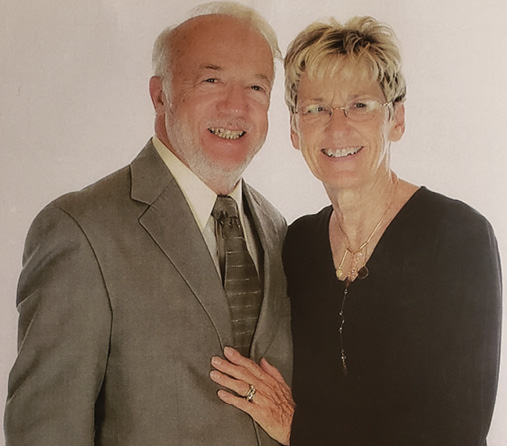
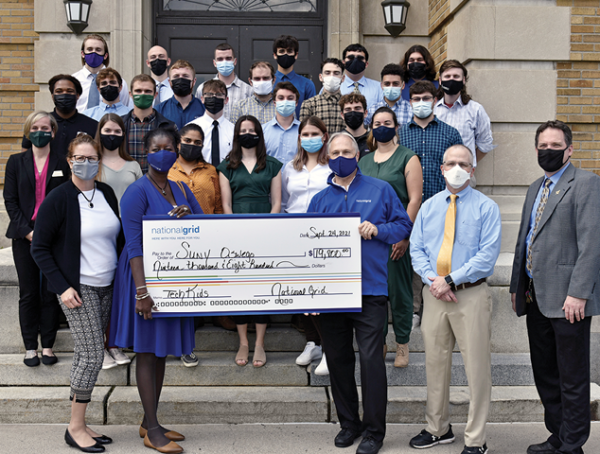
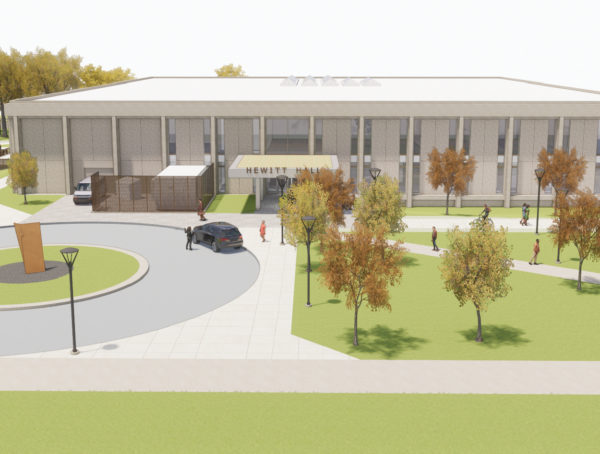
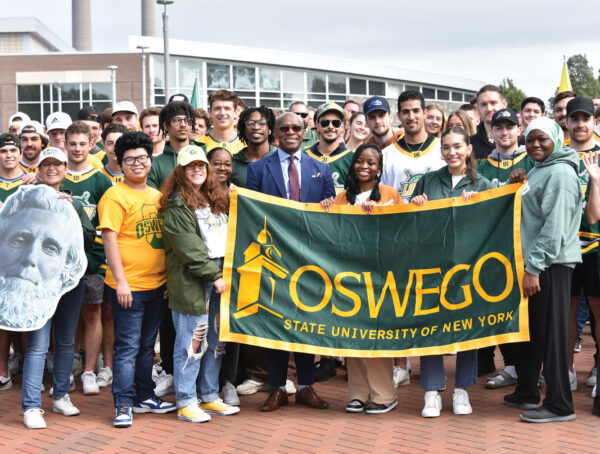
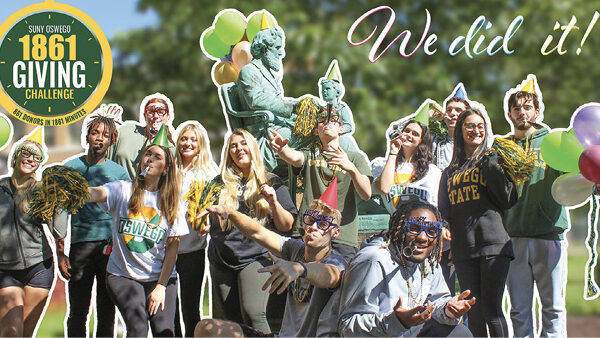
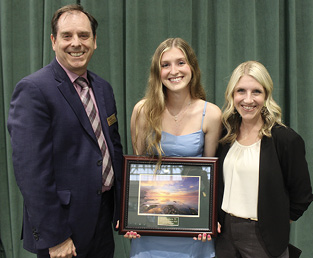
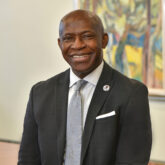

1 Comment
Another home run! The pace of improvement projects on campus is impressive, and each one is a jewel in and of itself. I can’t wait to tour the Shineman Center on alumni weekend.